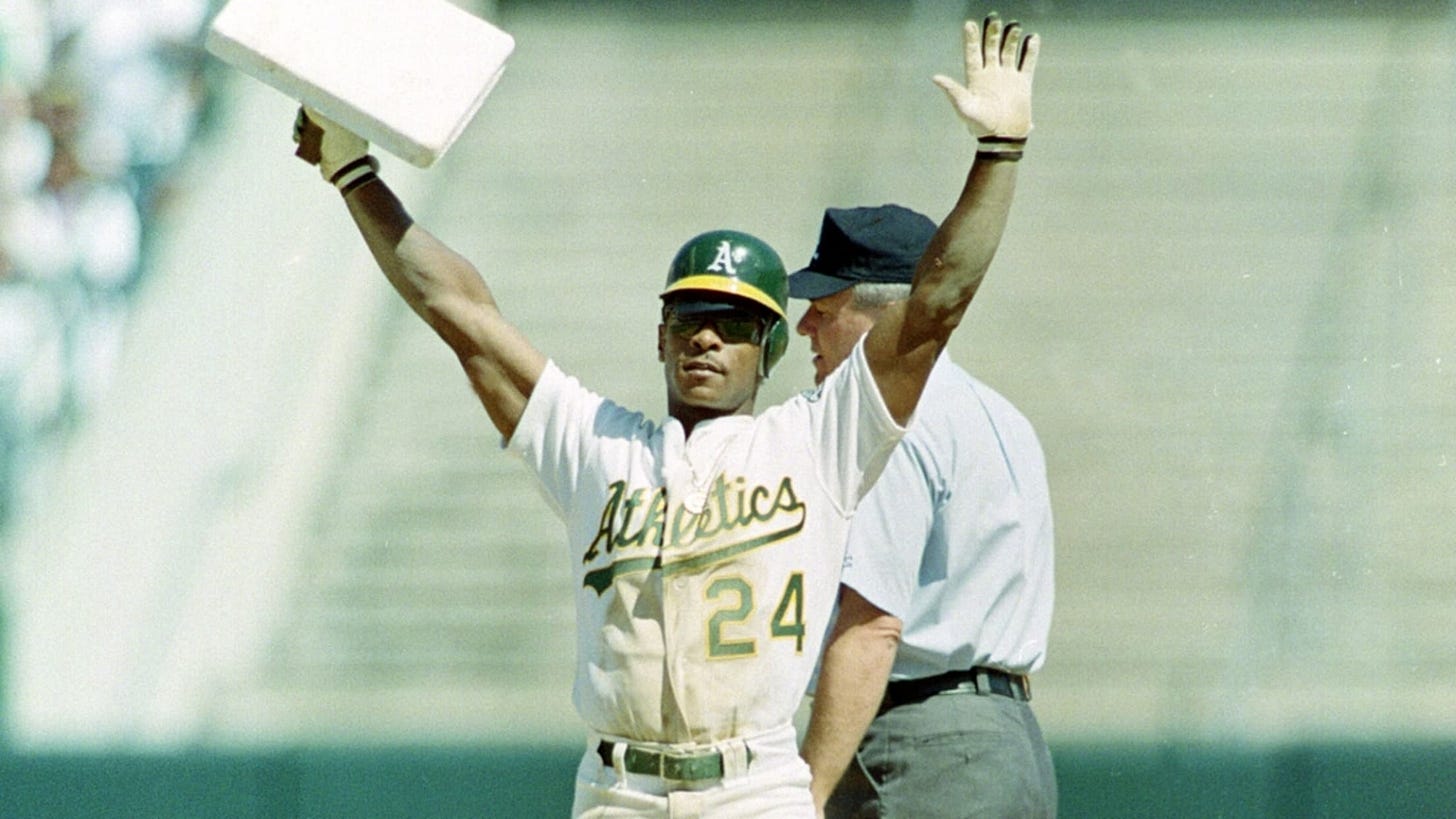Rickey Henderson - The Myth, The Legend, The Man of Steal
On December 21st we lost a one-of-a-kind legend, one which the sport will never see again.
On a day which was dominated by the start of the first ever 12-team college football playoff, the baseball world was unexpectedly struck with the sad news that Hall of Fame legend Rickey Henderson had died at the age of 65. Today, lets take a moment to dive into the unparalleled, unsurpassable, and unique career of The Man of Steal.
By traditional standards, Rickey was a superstar. He ranks 17th all time in Wins Above Replacement and has more stolen bases than anyone in history (468 more than Lou Brock in second-place). Among the 39 players to have amassed 500+ stolen bases, only he, Barry Bonds, and Joe Morgan have hit more than 250 home runs. Across a long 25-year career, Henderson was a 10-time all star, 3-time Silver Slugger, and the AL MVP in 1990.1 He led the league in stolen bases 12 times—the final time being at age 39—in WAR three times, and in walks four times. He was the quintessential lead-off hitter, raising the standard and re-defining the role for generations to come. But these traditional accomplishments do not even begin to fully illustrate the greatness that was the Man of Steal.
Unmatched on the Base Paths
When it comes to the stats that represent contribution on the base paths, few rivaled Rickey. He ranks first all-time in both stolen bases and FanGraphs' Weighted Stolen Bases (wSB)—a statistic that estimates the number of runs a player contributes to his team through stolen bases compared to the average player. While he also ranked 64th in on-base percentage (OBP) and 133rd in FanGraphs Baserunning (BsR)—FanGraphs’ all encompassing base running statistic that translates stolen bases, caught stealings, and other base running plays (i.e., taking extra bases, being thrown out on the bases, etc) into runs above or below average. Taking those stats together and averaging those rankings using a geometric mean, Rickey tops the charts as the most dominant contributor on the basepaths.2
His prowess for stealing bases was truly magnificent. Over his career, Henderson vastly out-stole what we would expect based on his calculated speed and baserunning ability, based on FanGraphs’ Spd statistic.3
A Quarter-Century of Dominance
What may be just as incredible as what Rickey was able to accomplish, is how long he was able to stay so good. The average length of a Baseball Hall of Famers career is 18 years, Rickey played 25 seasons across four decades. And while most players tend to start their careers a bit below their peak and fade off in their last few seasons, Rickey was different. For his entire career, Rickey blew away the rest of the league in baserunning production, per BsR.
In his 1979 rookie campaign, Henderson was over 2-points above the league average.4 He continued to be at least 2-points above league average for the next 14 years, and across 20 of his 25 professional seasons, never once falling below league average.
As mentioned, Rickey was a leadoff hitter, and the main role of the leadoff man is to get on base.5 Henderson sat above league average in on-base percentage in all but his final season (which, I may add, consisted of only 30 games and 72 at bats, well below the qualifying minimum for league-wide rankings and awards).
Between 1980 and 1998 (19 seasons) Rickey stole at least 45 bases 15 times, with seven of those seasons being above 75. To put it into perspective, 45 SB’s would have placed 4th in MLB in 2024. That number would have led baseball in 2022, the final year before the rule changes to increase the number of stolen bases (which Rickey did not have the advantage of…imagine if he player under today’s rules!!).
While we mourn the unexpected loss of Rickey Henderson, let as take a moment to appreciate his greatness and the way in which he changed baseball for generations to come. I can say in confidence that his stolen base record of 1,406 will never, ever, even come close to being broken. For that I am thankful, as it means the Man of Steal will forever have his name etched on the front page of the baseball history books, right where it belongs.
The geometric mean was used to neutralize the outlier effect and control against the average being skewed by a player being extremely high or low relative to their rankings in the other metrics.
Per FanGraphs Glossary: Speed score (Spd) is a statistic developed by Bill James that rates a player on their speed and baserunning ability. Different locations include slightly different components, but the FanGraphs version consists of, “…Stolen Base Percentage, Frequency of Stolen Base Attempts, Percentage of Triples, and Runs Scored Percentage.”
Which can be interpreted as generating an estimated 2+ more baserunning runs than the average player.
Shall I quote Billy Beane in Moneyball?




